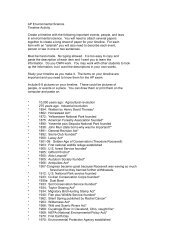Tule Elk Pub - Head-Royce School
Tule Elk Pub - Head-Royce School
Tule Elk Pub - Head-Royce School
Create successful ePaper yourself
Turn your PDF publications into a flip-book with our unique Google optimized e-Paper software.
<strong>Tule</strong> <strong>Elk</strong><br />
The Return of a Species<br />
S<br />
ailing past the Point Reyes peninsula in the year 1800, explorers saw large<br />
herds of elk roaming through open grasslands. Sixty years later, the elk were<br />
gone from Point Reyes and by 1870 they were thought to be extinct statewide.<br />
Today, elk again roam along the hills of Tomales Point and several other areas within<br />
California. This is the story of their remarkable comeback.<br />
Point Reyes National Seashore<br />
Inside<br />
Making Responsible<br />
Choices for the Future 2<br />
<strong>Elk</strong> Facts 3<br />
How You Can Help 4<br />
<strong>Elk</strong> Watching Tips 4<br />
Historic<br />
<strong>Tule</strong> <strong>Elk</strong> Range<br />
Population: 500,000<br />
<strong>Elk</strong> Herd<br />
1870<br />
Population: fewer than 10<br />
A Look into the Past<br />
The tule elk (Cervus elaphus nannodes) is a subspecies<br />
of elk native to California. They occur nowhere<br />
else. For thousands of years, as many as<br />
500,000 tule elk thrived in California – from the<br />
lush open country of the Central Valley to the<br />
grassy hills on the coast. But following the Gold<br />
Rush of 1849, the elk were hunted nearly to extinction.<br />
At the same time, elk habitat was converted<br />
to agriculture, and livestock grazed what had been<br />
elk forage. These developments caused the elk’s<br />
decline and nearly caused their extinction.<br />
Imagine the surprise of the ranch workers in 1874<br />
who discovered several tule elk while draining a<br />
marsh to create agricultural fields. Not a single<br />
tule elk had been seen for four years! Fortunately<br />
the landowner, Henry Miller, felt compelled to<br />
protect these last elk, and by 1905 their population<br />
had grown to 140. When the elk began to eat<br />
Miller’s crops and trample his fences, he captured<br />
some and moved them to other locations in California.<br />
This was the first time the elk were moved<br />
for conservation purposes. It was not to be the last.<br />
Revival and Recovery<br />
<strong>Tule</strong> elk received official protection in 1971 with<br />
state Senate Bill 722, called the Behr Bill after its<br />
author, Peter Behr. This bill prohibited hunting of<br />
tule elk – then numbering 500 – until their population<br />
reached 2,000. As a result of management by<br />
the California Department of Fish and Game, the<br />
tule elk population grew to 2,000 in 1989. By 1998,<br />
there were more than 3,000 elk in California.<br />
In 1976, <strong>Pub</strong>lic Law 94-389 directed the federal<br />
government to make suitable lands available for<br />
“the preservation and grazing of tule elk.” Two<br />
years later, ten tule elk were moved to Tomales<br />
Point, the northernmost part of Point Reyes National<br />
Seashore. There they survived a decade of<br />
drought. With the return of the rains in the early<br />
1990s, range conditions improved dramatically<br />
and the elk herd grew rapidly. By 1998, the herd<br />
size surpassed 500 animals, one of the largest of<br />
the 22 herds currently in the state.<br />
A Challenge for the Future<br />
Today’s tule elk population is larger than it has<br />
been for 130 years: 3,200 and growing. California’s<br />
human population, now approximately<br />
32 million, is also growing. As the human population<br />
expands, wildlife habitat is being converted to<br />
human habitat – housing, stores, schools and<br />
highways. As a result, the elk have fewer and fewer<br />
places to roam. <strong>Tule</strong> elk will probably never return<br />
to their historic numbers nor to all of their historic<br />
range because of this human growth and lack of<br />
suitable elk habitat. But, if they and other wildlife<br />
are to survive, human expansion into the landscape<br />
must be balanced with the need to maintain<br />
the treasured open spaces of California.<br />
1998<br />
Population: 3,200<br />
“We are the only species which, when it chooses to do so, will go to great effort<br />
to save what it might destroy.” –Wallace Stegner<br />
Patricia Kirby
Making Responsible Choices for the Future<br />
Population Growth and Range Limitations<br />
Since their reintroduction to the Point Reyes peninsula, the tule elk have lived within a<br />
2,600-acre reserve at Tomales Point. Their range is restricted by the Pacific Ocean to the<br />
north and west, Tomales Bay to the east, and a three-mile-long, ten-foot-tall fence to the<br />
south. Given the mild climate and lush habitat of Tomales Point, the elk live in a virtual<br />
paradise. As long as there is abundant rainfall and forage, they will continue to multiply.<br />
Vitality and youth characterize the existing herd, as more than half the animals are less<br />
than five years old. Several hundred of the females are old enough to reproduce.<br />
Fewer than 5 percent of the elk die each year; they have an average life span of twelve<br />
years. As the herd grows within the restricted Tomales Point area, they place a greater demand<br />
on their habitat. Without adequate rainfall, their forage could become deficient,<br />
causing them to suffer stress, starvation, and eventually a population crash.<br />
The Point Reyes Solution<br />
Phil Jonik<br />
Since 1993, researchers and biologists from the National Park<br />
Service, U.S. Geological Survey, University of California at Davis<br />
and Berkeley, Humboldt State University, and the California<br />
Department of Fish and Game have studied the complex question<br />
of how to accommodate the growing elk herd. They looked<br />
at the herd’s composition and size, incidence of disease, impact<br />
on endangered species, and the condition of the plant communities<br />
on Tomales Point. These studies provided the information<br />
necessary for the park to develop a management plan to ensure<br />
the health of the herd.<br />
After consideration of a number of alternatives and public<br />
review, the park is implementing a scientific approach to manage<br />
the tule elk herd. The approach involves three major components:<br />
the continuation of research, relocation, and<br />
immunocontraception.<br />
In the environmental assessment, several other options were<br />
explored but rejected:<br />
q Sterilization was eliminated as an option because of its<br />
irreversibility and its intrusive, inhumane implications.<br />
q Due to possible disease transmission and competition with<br />
cattle for forage, removing the elk fence at Tomales Point<br />
will not be considered as long as the adjacent dairy ranches<br />
are in operation.<br />
q In order to leave the wildlife wild, the park will not attempt<br />
to establish new herds that require permanently fenced,<br />
restricted ranges.<br />
q Hunting elk within the park is not an option because of<br />
strong public opposition and safety concerns.<br />
Management Actions<br />
Research<br />
The Seashore will continue its intensive research effort,<br />
studying tule elk ecology and population dynamics.<br />
Researchers will explore methods to alter elk population<br />
size where and when necessary, look at abundance of<br />
food and water, predation, disease, and population<br />
control techniques. This research information will<br />
help the Seashore revise the management plan to<br />
accommodate new situations and changing conditions.<br />
Relocation<br />
As a scientific trial to establish the effectiveness<br />
of expanding their habitat, up to 70 elk will be moved<br />
to the Limantour wilderness area from the existing herd at<br />
Tomales Point. Working with other agencies, the Seashore will<br />
seek to relocate elk elsewhere in the state to establish new herds<br />
in the historic range.<br />
Immunocontraception<br />
Based on the recommendations of three scientific<br />
panels, the Seashore is studying a form of contraception<br />
called immuno-contraception within the Tomales Point herd.<br />
The immunogen, administered in a dart, works by stimulating<br />
the cow’s immune system to produce antibodies that block<br />
sperm from attaching to the ovum. This contraceptive is<br />
reversible and antibodies resulting from the vaccine do not<br />
pass through the food chain.<br />
This means there is no known<br />
environmental byproduct – no<br />
other plants or animals will be<br />
affected in any way. Annual<br />
booster shots may be necessary<br />
before the next breeding season.<br />
In August 1997, the Seashore<br />
began a pilot study of immunocontraception.<br />
Research will deter<br />
mine if this “elk birth control” can<br />
be used effectively with the future<br />
relocated elk population at Point<br />
Reyes National Seashore.<br />
2<br />
<strong>Elk</strong> add diversity and beauty to the Point Reyes peninsula, restore the natural and cultural character of the land and enrich<br />
our lives. As a result, we must be committed to making responsible choices that ensure the elk’s survival.<br />
Gary Nichols
<strong>Elk</strong> Facts<br />
Life Cycle<br />
Female elk are sexually mature by two years of age, although they may be able to<br />
breed as yearlings. Nearly all female elk will reproduce during their lifetime.<br />
A female is likely to have six to ten calves in her lifetime. Males are sexually mature<br />
at age two, but usually aren’t able to breed until they are strong enough to compete<br />
with other bulls to defend a harem of cows. Half the the male population will<br />
remain bachelors; most breeding is accomplished by ten percent of the male population.<br />
Gestation period: Calves are born 8.5 months after conception. They nurse for four<br />
or five months, but start nibbling on grass when they are less than one month old.<br />
Lifespan: Twelve years is an average lifespan for wild elk; some elk have been<br />
known to live 25 years in captivity.<br />
Predators<br />
The tule elk at Point Reyes National Seashore are practically free from predators.<br />
Humans could kill elk with weapons, but hunting is not allowed in the Seashore.<br />
Black and grizzly bears usually eat plants, but they would eat elk too. However,<br />
there are no longer bears in the park.<br />
Coyotes are found at the Seashore, and will kill elk calves, but an elk’s flailing<br />
hooves can easily kill a coyote. No coyote attacks on elk have been recorded in the<br />
Seashore.<br />
Mountain lions can kill elk of any age, but find smaller deer an easier target.<br />
No mountain lion interactions with elk have been documented in the park.<br />
Antlers vs. Horns<br />
Antlers are often confused with horns.<br />
Horns are slow-growing and permanent,<br />
usually grown by both sexes, and are made<br />
of a bone core covered by a thin layer of<br />
keratin.<br />
Gary Nichols<br />
<strong>Tule</strong> <strong>Elk</strong> Ranges<br />
Existing <strong>Elk</strong> Range<br />
Relocation <strong>Elk</strong> Range<br />
Antlers usually grow only on males and are<br />
made completely of bone. They are shed<br />
and regrown annually. In the spring, they<br />
are covered with “velvet,” a system of blood<br />
vessels that nourish the bone as it grows. A<br />
set of elk antlers can weigh up to 40 pounds.<br />
The size and symmetry of the antlers reflect<br />
the health as well as the age of the animal.<br />
A “spike bull” is less than two years old and<br />
has only one point on his antlers. Older<br />
bulls have more points, but they do not<br />
grow a point for each year of age.<br />
Antlers are used as weapons by the males to<br />
compete for the chance to breed. A young<br />
bull is easily intimidated by a mature bull’s<br />
large rack of antlers. Two evenly matched<br />
bulls may use their antlers in combat, if<br />
other attempts at intimidation (vocalizations<br />
and posturing) have failed.<br />
A bull who has proven himself bigger and<br />
stronger than the others defends a harem of<br />
up to 30 females. This means he is the<br />
primary bull, responsible for 80% of the<br />
breeding. Towards the end of the breeding<br />
season, other “secondary” bulls may get the<br />
opportunity to breed as the primary bull<br />
tires.<br />
Patricia Kirby<br />
3
How You Can Help the <strong>Elk</strong><br />
A number of organizations are concerned about the welfare of elk in California<br />
and throughout the U.S.A. They provide a range of services, from educational<br />
materials to buying and managing land for elk habitat. You can get involved<br />
in a number of ways, among which are the following:<br />
q Donate – Give to and help raise money for agencies and nonprofit groups<br />
that protect habitat.<br />
q<br />
q<br />
<strong>Elk</strong> Watching Tips<br />
For your own safety, always observe elk from a<br />
distance. Use binoculars and spotting scopes. If<br />
an elk becomes alert or nervous and begins to<br />
move away, you are too close.<br />
If viewing from your car, pull off the road or<br />
park in designated areas.<br />
q Protect Habitat – Prevent domestic dogs from roaming, follow park regulations<br />
and guidelines listed here and at trailheads.<br />
q Learn – Find out more about elk from the organizations listed below. Share<br />
information with friends and family.<br />
q Volunteer – Be an elk docent on summer and fall weekends at Point Reyes<br />
National Seashore. Call (415) 663-8522, ext. 285 for an application.<br />
q If you are on foot, stay on the trail; do not come<br />
between a cow and calf, a bull and a group of<br />
cows, or two bulls challenging each other.<br />
q Watch quietly; whisper. Move slowly.<br />
q Do not feed the elk. Feeding elk or any other<br />
wildlife is unhealthy for the animals, potentially<br />
dangerous for visitors, and strictly prohibited.<br />
For More Information<br />
The Committee for the Preservation<br />
of the <strong>Tule</strong> <strong>Elk</strong><br />
Post Office Box 3696<br />
San Diego, CA 92103-0220<br />
The Rocky Mountain <strong>Elk</strong> Foundation<br />
2291 West Broadway<br />
Missoula, MT 59802-1813<br />
California Department of Fish and<br />
Game<br />
1416 West Ninth Street<br />
Sacramento, CA 95814<br />
Point Reyes National Seashore<br />
Association<br />
Point Reyes Station, CA 94956<br />
q Ride your bicycle only on designated trails.<br />
q Bring your pets only where they are allowed.<br />
q Do not collect or remove elk antlers. They are<br />
an important source of calcium for many wildlife<br />
species such as rodents and deer.<br />
Point Reyes National Seashore<br />
National Park Service 1998<br />
Managing Editor/Writer: Kim Linse<br />
<strong>Elk</strong> Program Manager: Tom Kucera<br />
Editor: Nancy Adess<br />
Design/Layout: Patricia Kirby<br />
Graph and Maps: Scott Walker<br />
Line Drawings: Patricia Kirby<br />
Photo Credits: Gary Nichols,<br />
Patricia Kirby, and Phil Jonik<br />
National Park Service<br />
Point Reyes National Seashore<br />
Point Reyes Station, CA 94956<br />
BULK RATE<br />
U.S. POSTAGE PAID<br />
U.S. DEPARTMENT<br />
OF THE INTERIOR<br />
PERMIT NO. G-83<br />
National Park Service<br />
Printed on recycled paper.<br />
Gary Nichols











